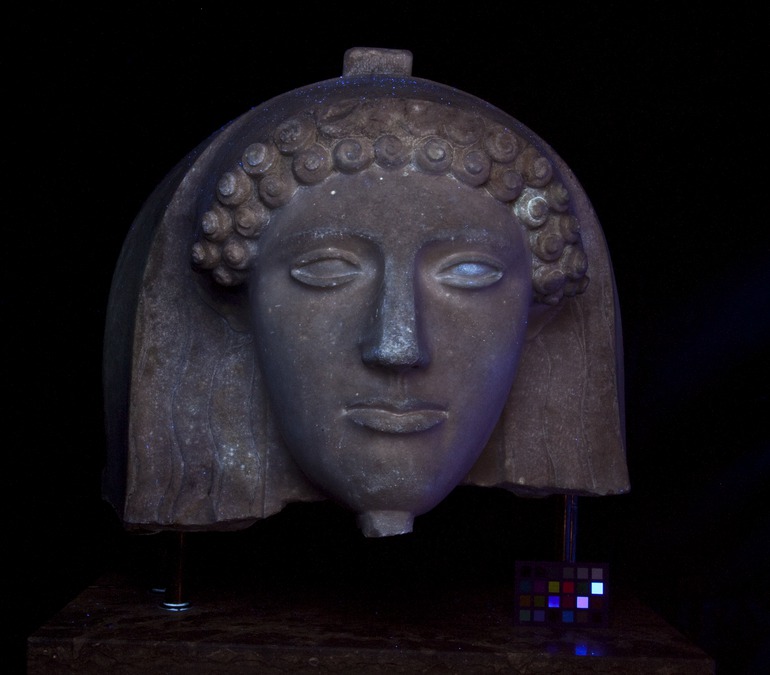Lid from a sarcophagus
Summary
The sarcophagus fragment is well preserved and shows extensive remains of antique polychromy. A white ground is found on the sides of the fragment, partially in the ears and on the hair, along the sides of the face and the left eye. However, it remains unknown if the white layer is part of an original ground. A clearly defined blue band of Egyptian blue runs on the side along the border. Parallel to the blue band a golden line is observed by means of ultra violet fluorescence (UVF). Visible induced luminescence imaging (VIL) of the face reveals an intentional use of Egyptian blue. Compact layers of the pigment are found in the hair whereas on the face the pigment is evenly distributed as scattered particles on the skin parts. Traces of red colour are found on the sides and on the tenon. Also, the face shows remains of red and occasionally yellow pigments.
Description of object
The male head is on the lid of an anthropoid sarcophagus. The head is very broad and covers the whole of the width of the lid. Over the man’s forehead are two rows of curly locks which spill out from the smooth skullcap. Flat locks of hair separated by grooves cover the background of the lid on both sides of the face. They seem to be unconnected with the curly locks. On the top of the head a tenon can be seen. This is one of the handles of the sarcophagus. The almond-shaped high places eyes are stressed by the heavy brows which meet above the nose ridge. The ears are set high, right below the curly locks. Under the chin is a remnant of the Egyptian chinbeard. A faint “archaic” smile softens the prevailing severe style. Some of the curly locks above the forehead have broken off. The nose has been scraped. The point of the beard is broken.
Choice of methods
Visual examination
- Macroscopic
- Microscopic in situ
Technical imaging
- UV
- VIL
Marble identification method
- 1993: Isotopic analysis
Visual examination
On the front of the sarcophagus fragment blue is found on and between the hairlocks most significantly on the right side. The face shows remains of blue colour in the mouth, the beard and in the corners of the eyes tiny grains of blue. On the skin the pigment is evenly distributed as scattered particles. Relatively large amounts of red colour is found on the hair and between the lips. Occasionnally traces of yellow is found in the hair locks along the sides of the face.
On the left side of the sarcophagus fragment a white layer is found on the side and in the left ear. A compact blue band runs on the side along the border. It remains unknown if the blue band appears is on top of the white layer. Scattered particles of the blue pigment is found on both the tenon, the side, hair locks, chinbeard and on the skin. Traces of red colour is found on the tenon, on the majority of hairlocks and the left ear.
On the right side of the sarcophagus a white layer is found along the edge of the side close to the hair and on the right ear. A blue band in combination with an even distribution of scattered particles of blue covers the right side as well as the tenon. Partcles of blue are localized on the hair locks, the chin beard, the right ear and on the skin parts. Few red grains are found on the side, on the hairlocks and in the ear and occasionally yellow grains are found on the side and on the skullcap.
Technical imaging
UVF: A strong bluish white fluorescens is observed in the left eye. Furthermore, a golden line appears on the side of the sarcophagus.
VIL: On the sides and the tenon of the sarcophagus fragement visible induced luminescenvce imaging reveals the extensive use of Egyptian blue. Also, on the hair and beard, between the lips, in the corners of the eyes and on the skin parts particles shining bright white document the presence of Egyptian blue.
Bibliography
F. Poulsen (1951), Catalogue of Ancient Sculpture in the Ny Carlsberg Glyptotek. Copenhagen: Cat. No. 22.
E. Kukhan (1955), Anthropoide Sarkophage in Beyrouth und die Geschichte dieser sidonischen Sarkophagkunst: 35. 83 no. 6.
D. Scilardi (1974), A new Phoenician sarcophagus from Paros, in AAA 6, 1974, 466-471, figs. 2-7.
E. Møller (1995), Catalogue. The Near Eastern CollectionNy Carlsberg Glyptotek: 54-55. no. 51.
K. Lembke (2001), Phönizische anthropoide Sarkophage, in Damaszener Forschungen 10: 91; IN 431: 123 no. 8, c. 450.
R. Bol & S. Frede (2005), Anthropoide Sarkophage in Phönizien, Nordafrika und Italien: Akzeptanz und Resistenz, in H. Beck, Peter C. Bol & M. Bückling (eds.), Ägypten, Griechenland, Rom. Abwehr und Berühung. Exh. Catalogue Städelsches Kunstinstitut und Städtische Galerie.Frankfurt 2005: 171 – 186.
- IN 431
- Sarcophagus
- c. 450 B.C.E.
- Classical
- Marble from Paros
- Bought in the 1880’s in Beirut.
- H. 40 cm.; W. 53 cm.; D. 3.5 cm.




